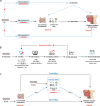Mendelian randomization analysis of gut microbiota-immune cell interactions in malignant neoplasm of nasopharynx
- PMID: 40663222
- PMCID: PMC12263519
- DOI: 10.1186/s13568-025-01909-2
Mendelian randomization analysis of gut microbiota-immune cell interactions in malignant neoplasm of nasopharynx
Abstract
Observational studies have suggested associations among the gut microbiome, immune cells, and the risk of malignant neoplasms of nasopharynx. However, the causality of these relationships remains unclear. Thus, we conducted multiple Mendelian Randomization analyses to estimate the causal association of gut microbiota with the risk of malignant neoplasms of nasopharynx and to evaluate the mediating effect of immune cells on this causal pathway. Genetic variants extracted from genome-wide association studies of human gut microbiota compositions (n = 211), immune cell traits (n = 731) and malignant neoplasms of nasopharynx served as instrumental variables for calculating causal associations and mediating effects. Four gut microbiota compositions and eight immune cell traits exhibited detrimental causal effects, while three gut microbiota compositions and fifteen immune cell traits demonstrated protective effects. Interestingly, the causal association of genus Candidatus Soleaferrea id.11350 was no longer significant after adjusting for two established immune cell traits (HLA DR + + monocyte %leukocyte and HLA DR + + monocyte % monocyte). Moreover, HLA DR + + monocyte %leukocyte exhibited a mediating effect (OR 0.75, 95% CI 0.59-0.96) on the causal pathway of genus Candidatus Soleaferrea id.11350-malignant neoplasms of nasopharynx, with a mediating proportion of 21.59%. To our knowledge, this study is the first to identify potential therapeutic targets and elucidate mechanistic insights for malignant neoplasms of nasopharynx interventions involving gut microbiota and immune cell traits; however, these findings warrant further validation through adequately powered randomized clinical trials (RCTs).
Keywords: Gut microbiome; Immune cells; Malignant neoplasm of nasopharynx; Mediation analysis; Mendelian randomization.
© 2025. The Author(s).
Conflict of interest statement
Declarations. Ethics approval and consent to participate: This study was approved by the ethics committee of The People's Hospital of Guangxi Zhuang Autonomous Region (KY-KJT-2023-101). This MR study only used the summary data of GWAS study, without any identifiable private information. Consent for publication: The authors declare consent for publication. Competing interests: The authors declare no competing interests.
Figures





Similar articles
-
Inflammatory cytokines mediate the gut microbiota-EGPA subtype link: a Mendelian randomization study.Clin Rheumatol. 2025 Jul;44(7):3061-3071. doi: 10.1007/s10067-025-07526-5. Epub 2025 Jun 12. Clin Rheumatol. 2025. PMID: 40500572
-
Gut microbiota constituents may affect hypertrophic scarring risk through interaction with specific immune cells in a two-step, two-sample Mendelian randomization study.Sci Rep. 2025 Jul 1;15(1):20656. doi: 10.1038/s41598-025-07455-y. Sci Rep. 2025. PMID: 40596527 Free PMC article.
-
Genetic prediction of immune cells, inflammatory proteins, and metabolite-mediated association between gut microbiota and COPD: a Mendelian randomization study.Sci Rep. 2025 Jul 1;15(1):21633. doi: 10.1038/s41598-025-05290-9. Sci Rep. 2025. PMID: 40594427 Free PMC article.
-
Systemic pharmacological treatments for chronic plaque psoriasis: a network meta-analysis.Cochrane Database Syst Rev. 2021 Apr 19;4(4):CD011535. doi: 10.1002/14651858.CD011535.pub4. Cochrane Database Syst Rev. 2021. Update in: Cochrane Database Syst Rev. 2022 May 23;5:CD011535. doi: 10.1002/14651858.CD011535.pub5. PMID: 33871055 Free PMC article. Updated.
-
Systemic pharmacological treatments for chronic plaque psoriasis: a network meta-analysis.Cochrane Database Syst Rev. 2017 Dec 22;12(12):CD011535. doi: 10.1002/14651858.CD011535.pub2. Cochrane Database Syst Rev. 2017. Update in: Cochrane Database Syst Rev. 2020 Jan 9;1:CD011535. doi: 10.1002/14651858.CD011535.pub3. PMID: 29271481 Free PMC article. Updated.
References
-
- Atabieke F, Aierken A, Aierken M, Rehaman M, Zhang QQ, Li J, Xia Y, Aizezi Y, Dilixiati D, Gao HL, Zhang ZQ (2025) Investigating casual association among gut microbiome and esophageal cancer: a Mendelian randomization study. Medicine (Baltimore) 104:e41563. 10.1097/md.0000000000041563 - PMC - PubMed
-
- Bai Y, Zhang M, Chen L, Zhou P, Zhou B, Wang R, Li R, Si J, Zhou S, Jiang Y (2025) Gastrointestinal traits, common inflammatory disorders, gallstones, and biliary tract cancer: a network Mendelian randomization study. J Adv Res. 10.1016/j.jare.2025.03.010 - PubMed
-
- Blake SJ, Wolf Y, Boursi B, Lynn DJ (2024) Role of the microbiota in response to and recovery from cancer therapy. Nat Rev Immunol 24:308–325. 10.1038/s41577-023-00951-0 - PubMed
Grants and funding
LinkOut - more resources
Full Text Sources
Research Materials

